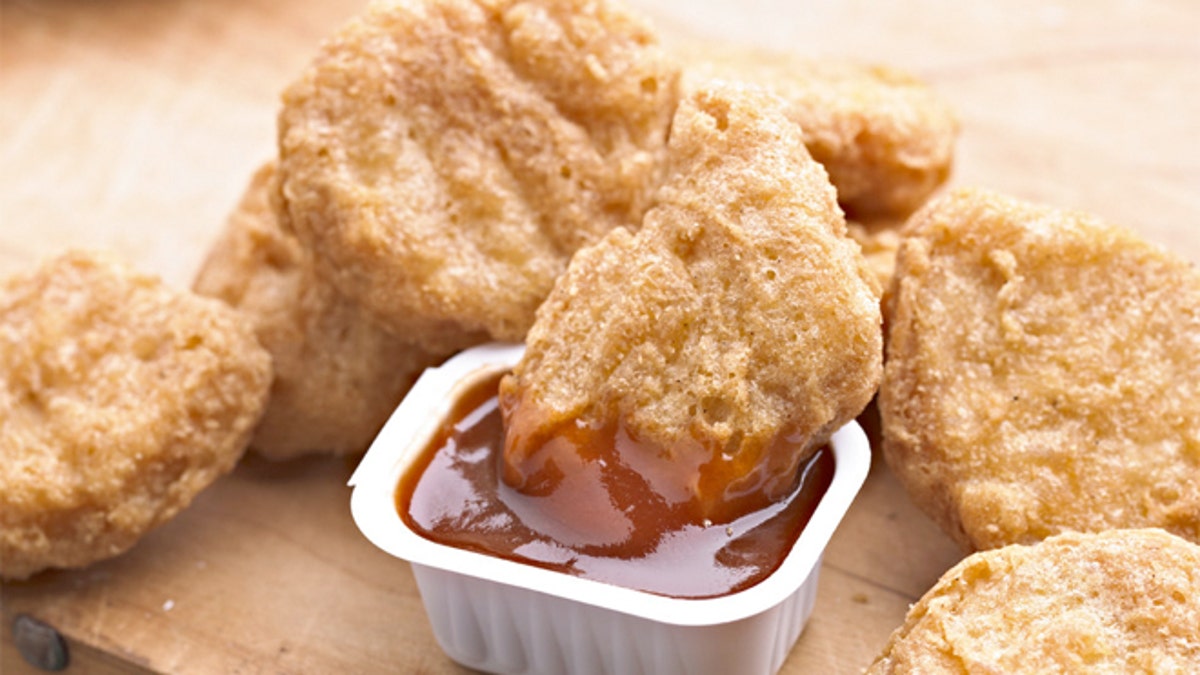
A recent study show that chicken nuggets contain less than half of chicken meat --with the rest comprising bone, blood vessels and organs. (iStock)
Despite their somewhat controversial history, Americans love chicken nuggets--even after reports reveal what they're really made of.
The most recent is from a study published in The American Journal of Medicine. Researchers at the University of Mississippi Medical Center in Jackson dissected two chicken nuggets and discovered they contained 50 percent or less chicken meat, with the rest consisting of fat, blood vessels, nerve, cartilage or pieces of bone, according to Reuters.
Dr. Richard D. deShazo-- lead author of "The Autopsy of Chicken Nuggets Reads 'Chicken Little'”-- had his team buy a box of chicken nuggets from two national food chains, the names of which they won’t disclose. The researchers picked one chicken nugget from each box to be preserved, dissected and stained, then examined under a microscope.
They discovered that nugget number one was about 50 percent muscle tissue such as from the breast or thigh. The rest of it was made from fat, blood vessels and nerves, specifically the cells that line the skin and internal organs of the chicken.
Nugget number two was 40 percent muscle. The rest was fat, cartilage and bone.
"It is really a chicken by-product high in calories, salt, sugar and fat that is a very unhealthy choice. Even worse, it tastes great and kids love it and it is marketed to them," DeShazo told Reuters.
The history of the chicken nugget goes back to 1963 when Cornell University professor Robert C. Baker proposed a processed breaded chicken product called a “chicken stick” that made it possible for chicken nuggets to be formed in any shape. Since then, nuggets have taken up a prominent position on restaurant menus and are a regular in the frozen food aisle, much to the chagrin of public-health campaigners who point to them as a major contributor of obesity.
Yet, kids love nuggets even when they are shown what chicken parts go into them, as evidenced by chef and cookbook author Jamie Oliver's demonstration in 2010 on his show, "Jamie Oliver's Food Revolution."
So why do Americans keep coming back to chicken nuggets?
"I think that chicken nuggets split the difference between real fried chicken (what's there not to like?) and Doritos," said Michael Krondl, food historian and author of Sweet Invention: A History of Dessert. "Basically something crisp and fried that you can pop into your mouth. The entree version of a donut hole."
Yet, it's that well-aligned, pop-in-you-mouth shape that has led to many misconceptions about the making of the chicken nugget.
Contrary to what has been claimed, mechanically separated chicken --which is a paste-like meat product where the chicken is pushed under high pressure through a sieve to separate the bone from the edible meat--is not typically found in chicken nuggets, according to MeatSafety.org, a website maintained by the American Meat Institute. Also, according to the National Chicken Council, a non-profit trade group representing the U.S. chicken industry, transglutaminase or “meat glue” is not used to hold chicken nuggets together.
In response to the latest study, the NCC told Reuters that if you really wanted to find out what was in a chicken nugget, most companies post the ingredients and nutritional information.
We took a look at the websites of some major fast food chains, and while some do list ingredients, it is hard to determine what is really inside.
Burger King, on its website, says its chicken nuggets are made with “premium white meat.” The KFC website says each bite contains “100% breast meat,” while Wendy’s Chicken Nuggets claims “our nuggets are made with all white-meat chicken.” McDonald’s Chicken McNuggets, according to its website, says the nuggets “are made with USDA-inspected white meat.”
Fast food chains are increasingly trying to present a health conscious image. Last year, McDonald's initiated a transparency campaign to try and debunk negative myths about the chain’s food quality. But, these studies are likely continue as long as Americans continue to gobble up chicken nuggets by the millions.
